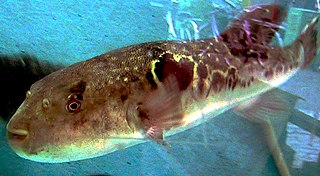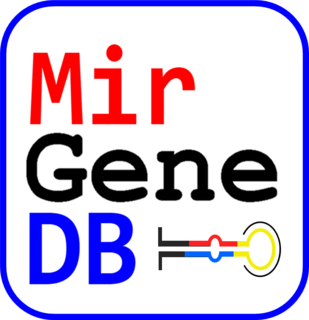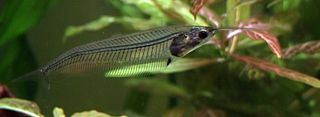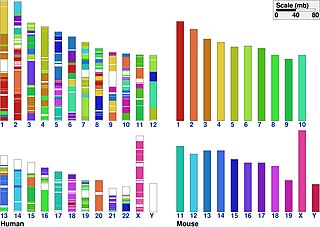
Haikouichthys is an extinct genus of craniate believed to have lived 525 million years ago, during the Cambrian explosion of multicellular life. Haikouichthys had a defined skull and other characteristics that have led paleontologists to label it a true craniate, and even to be popularly characterized as one of the earliest fishes. Cladistic analysis indicates that the animal is probably a basal chordate or a basal craniate; but it does not possess sufficient features to be included uncontroversially even in either stem group. It was formally described in 1999.

A craniate is a member of the Craniata, a proposed clade of chordate animals with a skull of hard bone or cartilage. Living representatives are the Myxini (hagfishes), Hyperoartia, and the much more numerous Gnathostomata. Formerly distinct from vertebrates by excluding hagfish, molecular and anatomical research in the 21st century has led to the reinclusion of hagfish, making living craniates synonymous with living vertebrates.

Pikaia gracilens is an extinct, primitive chordate animal known from the Middle Cambrian Burgess Shale of British Columbia. Sixteen specimens are known from the Greater Phyllopod bed, where they comprised 0.03% of the community. It resembled the lancelet and perhaps swam much like an eel.
The ParaHox gene cluster is an array of homeobox genes from the Gsx, Xlox (Pdx) and Cdx gene families.

Ensembl genome database project is a joint scientific project between the European Bioinformatics Institute and the Wellcome Trust Sanger Institute, which was launched in 1999 in response to the imminent completion of the Human Genome Project. Ensembl aims to provide a centralized resource for geneticists, molecular biologists and other researchers studying the genomes of our own species and other vertebrates and model organisms. Ensembl is one of several well known genome browsers for the retrieval of genomic information.

Paleopolyploidy is the result of genome duplications which occurred at least several million years ago (MYA). Such an event could either double the genome of a single species (autopolyploidy) or combine those of two species (allopolyploidy). Because of functional redundancy, genes are rapidly silenced or lost from the duplicated genomes. Most paleopolyploids, through evolutionary time, have lost their polyploid status through a process called diploidization, and are currently considered diploids e.g. baker's yeast, Arabidopsis thaliana, and perhaps humans.
Hox genes, a subset of homeobox genes, are a group of related genes that specify regions of the body plan of an embryo along the head-tail axis of animals. Hox proteins encode and specify the characteristics of 'position', ensuring that the correct structures form in the correct places of the body. For example, Hox genes in insects specify which appendages form on a segment, and Hox genes in vertebrates specify the types and shape of vertebrae that will form. In segmented animals, Hox proteins thus confer segmental or positional identity, but do not form the actual segments themselves.

Ciona intestinalis is an ascidian, a tunicate with very soft tunic. Its Latin name means, literally, "pillar of intestines", referring to the fact that its body is a soft, translucent column-like structure, resembling a mass of intestines sprouting from a rock. It is a globally distributed cosmopolitan species. Since Linnaeus described the species, Ciona intestinalis has been used as a model invertebrate chordate in developmental biology and genomics. Studies conducted between 2005 and 2010 have shown that there are at least two, possibly four, sister species. More recently its has been shown that one of these species has already been described as Ciona robusta. By anthropogenic means, the species has invaded various parts of the world and is known as an invasive species.

Takifugu rubripes, commonly known as the Japanese puffer, Tiger puffer, or torafugu, is a pufferfish in the genus Takifugu. It is distinguished by a very small genome that has been fully sequenced because of its use as a model species and is in widespread use as a reference in genomics.
The 2R hypothesis or Ohno's hypothesis, first proposed by Susumu Ohno in 1970, is a hypothesis that the genomes of the early vertebrate lineage underwent two complete genome duplications, and thus modern vertebrate genomes reflect paleopolyploidy. The name derives from the 2 rounds of duplication originally hypothesized by Ohno, but refined in a 1994 version, and the term 2R hypothesis was probably coined in 1999. Variations in the number and timings of genome duplications typically still are referred to as examples of the 2R hypothesis. The 2R hypothesis has been the subject of much research and controversy; however, with growing support from genome data, including the human genome, the balance of opinion has shifted strongly in favour of support for the hypothesis. According to Karsten Hokamp, Aoife McLysaght and Kenneth H. Wolfe, the version of the genome duplication hypothesis from which 2R hypothesis takes its name appears in Holland et al. and the term was coined by Austin L. Hughes.

Gene redundancy is the existence of multiple genes in the genome of an organism that perform the same function. This is the case for many sets of paralogous genes. When an individual gene in such a set is disrupted by mutation or targeted knockout, there can be little effect on phenotype as a result of gene redundancy, whereas the effect is large for the knockout of a gene with only one copy.

A microchromosome is a type of very small chromosome which is a typical component of the karyotype of birds, some reptiles, fish, and amphibians; they tend to be absent in mammals. They are less than 20 Mb in size; chromosomes which are greater than 40 Mb in size are known as macrochromosomes, while those between 20 and 40 Mb are classified as intermediate chromosomes. Microchromosomes are characteristically very small and often cytogenetically indistinguishable in a karyotype. While originally thought to be insignificant fragments of chromosomes, in species where they have been studied they have been found to be rich in genes. In chickens, microchromosomes have been estimated to contain between 50 and 75% of all genes. The presence of microchromosomes makes ordering and identifying chromosomes into a coherent karyotype particularly difficult. During metaphase, they appear merely as 0.5-1.5 μm long specks. Their small size and poor condensation into heterochromatin means they generally lack the diagnostic banding patterns and distinct centromere locations used for chromosome identification.
Branchiostoma floridae is a lancelet of the genus Branchiostoma. The genome of this species has been sequenced, revealing that among the chordates, the morphologically simpler tunicates are actually more closely related to vertebrates than lancelets. An embryo of a Florida amphioxus has a larval pharynx with gill slits that is asymmetrical. The gill slits in the larval pharynx form in the center of the embryo when it is in its earliest stage of development (primordial) meaning the thick layer of endoderm is overlapped by a thin layer; which aids into making the B. floridae asymmetrical from left to right.

Branchiostoma lanceolatum is a lancelet in the subphylum Cephalochordata. It is a marine invertebrate with a notochord but no backbone and is used as a model organism to study the evolutionary development of vertebrates. The mitochondrial genome has been sequenced.
Odor molecules are detected by the olfactory receptors in the olfactory epithelium of the nasal cavity. Each receptor type is expressed within a subset of neurons, from which they directly connect to the olfactory bulb in the brain. Olfaction is essential for survival in most vertebrates; however, the degree to which an animal depends on smell is highly varied. Great variation exists in the number of OR genes among vertebrate species, as shown through bioinformatic analyses. This diversity exists by virtue of the wide-ranging environments that they inhabit. For instance, dolphins that are secondarily adapted to an aquatic niche possess a considerably smaller subset of genes than most mammals. OR gene repertoires have also evolved in relation to other senses, as higher primates with well-developed vision systems tend to have a smaller number of OR genes. As such, investigating the evolutionary changes of OR genes can provide useful information on how genomes respond to environmental changes. Differences in smell sensitivity are also dependent on the anatomy of the olfactory apparatus, such as the size of the olfactory bulb and epithelium.

MirGeneDB is a database of microRNA genes that have been validated and annotated as described in Fromm et al. 2015. The initial version contained 1'434 microRNA genes for human, mouse, chicken and zebrafish. Version 2.0 will contain more than 7'500 genes from 32 organisms representing nearly every metazoan group, and these microRNAs can be browsed, searched and downloaded. Planned release data for 2.0 is December 2017.


















